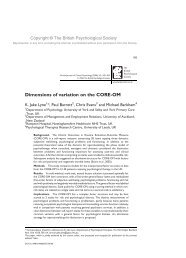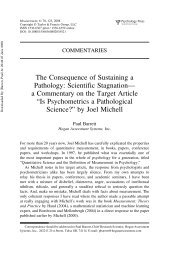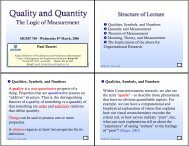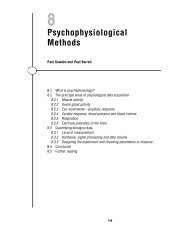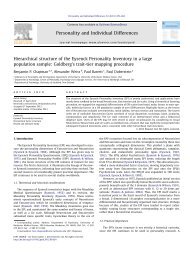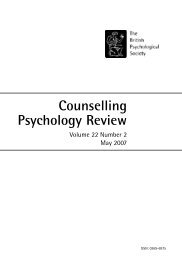What If There Were No Psychometrics?: Constructs ... - Paul Barrett
What If There Were No Psychometrics?: Constructs ... - Paul Barrett
What If There Were No Psychometrics?: Constructs ... - Paul Barrett
Create successful ePaper yourself
Turn your PDF publications into a flip-book with our unique Google optimized e-Paper software.
It is also illuminating to read a quotation from Kelley in 1929<br />
summing up the position that intelligence is a measurable<br />
variable:<br />
Our mental tests measure something, we may or may not care<br />
what, but it is something which it is to our advantage to measure,<br />
for it augments our knowledge of what people can be<br />
counted upon to do in the future. The measuring device as a<br />
measure of something that it is desirable to measure comes<br />
first, and what it is a measure of comes second. (p. 86)<br />
The problem with the original and neo-Pythagorean views<br />
is that they assume that all structures, entities, and phenomena<br />
can be described by the mathematics of quantity using quantitativelystructuredvariables.Thatmuchofthenaturalsciences<br />
could be described in this manner was taken as the signal that<br />
psychological constructs could be similarly measured, albeit<br />
with some initial difficulty. The original philosophy of Pythagoras<br />
had been distorted in the 17th through 19th centuries<br />
into what Michell (1999) called the “quantitative imperative.”<br />
<strong>If</strong> a discipline could not demonstrate measurement of its constructs<br />
and variables, then it could not be considered a science.<br />
However, science is a method or process for the investigation<br />
of phenomena. It does not require that the variables within its<br />
domain of enquiry be quantitatively structured. Quantitative<br />
science, in contrast, does demand such properties of its variables.<br />
<strong>There</strong>in lies the simple yet fundamental distinction between<br />
a quantitative science and a nonquantitative science. As<br />
Michell (2001) pointed out, there is no preordained necessity<br />
for variables within psychology to possess a quantitative<br />
structure. Psychology may remain a science yet deal with both<br />
quantitative and qualitative (nonquantitative) variables.<br />
Quantity is not synonymous with mathematics. <strong>If</strong> mathematics<br />
is considered as the science of abstract structure, then it is<br />
obvious that not all structures studied using mathematics are<br />
quantitative. For example, the structure of communication<br />
and social networks, graphs, language grammars, therapeutic<br />
interactions, automata networks, and so forth are essentially<br />
nonquantitative. The study of them may remain scientific in<br />
that the method of investigation and critical reasoning is appliedinaccordancewithscientificprinciples,butthevariables<br />
may be composed of a mixture of the quantitative and<br />
nonquantitative or solely nonquantitative. Further discussion<br />
of these issues and the substantive consequences of better understanding<br />
the logic of measurement rather than<br />
psychometrictesttheoryareprovidedin<strong>Barrett</strong>(2003,2005).<br />
CONCEPT COMPLEXITY AND BRUNSWIK<br />
(1952) SYMMETRY<br />
Within the section titled “Problems With Complex <strong>Constructs</strong>”<br />
of McGrath’s (2005/this issue) article, he notes that<br />
“Studies that have compared scales reflecting constructs at<br />
different levels of complexity consistently find that prediction<br />
WHAT IF THERE WERE NO PSYCHOMETRICS? 135<br />
is enhanced by using a larger number of more specific personality<br />
variables rather than a smaller number of more<br />
global ones [italics added]” (p. 114). I think Wittmann’s<br />
(1988; Wittmann & Süb, 1997) concept of “Brunswick Symmetry”<br />
based on the “lens” model introduced by Brunswik<br />
(1952) is important to introduce at this point, as it greatly<br />
clarifies thinking about the level of conceptual complexity of<br />
a predictor in relation to the level of complexity of a variable<br />
to be predicted. The Brunswik lens model assumes that there<br />
are three basic components in any decision-making event: a<br />
decision maker, information, and a decision criterion. The<br />
model describes the relations among the attributes of a stimulus<br />
object (the decision criterion), cues in the environment<br />
(information), and the judgement made by a perceiver (the<br />
decision maker). The extent to which a decision might be adjudged<br />
as accurate is dependent on how well the judgmental<br />
use of information equates with the actual value of the environmental<br />
cues/information. In other words, the more proximal<br />
the decision maker’s capacity for utilizing information is<br />
to the “objective” relationship of the information to the criterion,<br />
the better will be the decision. Wittmann and Süb extended<br />
this conceptualization to include symmetry relations<br />
between hierarchical predictor and criterion-variable sets<br />
such as those that might exist between variables that constitute<br />
a hierarchically organized model of personality or intelligence<br />
(the predictors) and those that constitute hierarchically<br />
organized elements of job performance. Figure 1, taken<br />
from Wittmann (2003), displays the schematic features of the<br />
Brunswik symmetry model.<br />
<strong>What</strong> this highlights is that the strongest possible relations<br />
between any two variables will be found where perfect level<br />
symmetry exists between them. So, for example, correlating<br />
the high-level predictor variable PR g with criterion variable<br />
CR g would be expected to yield a far higher value than if corre-<br />
FIGURE 1 The Brunswik symmetrical latent structure of nature<br />
(Wittmann, 2003). Reprinted by permission.



